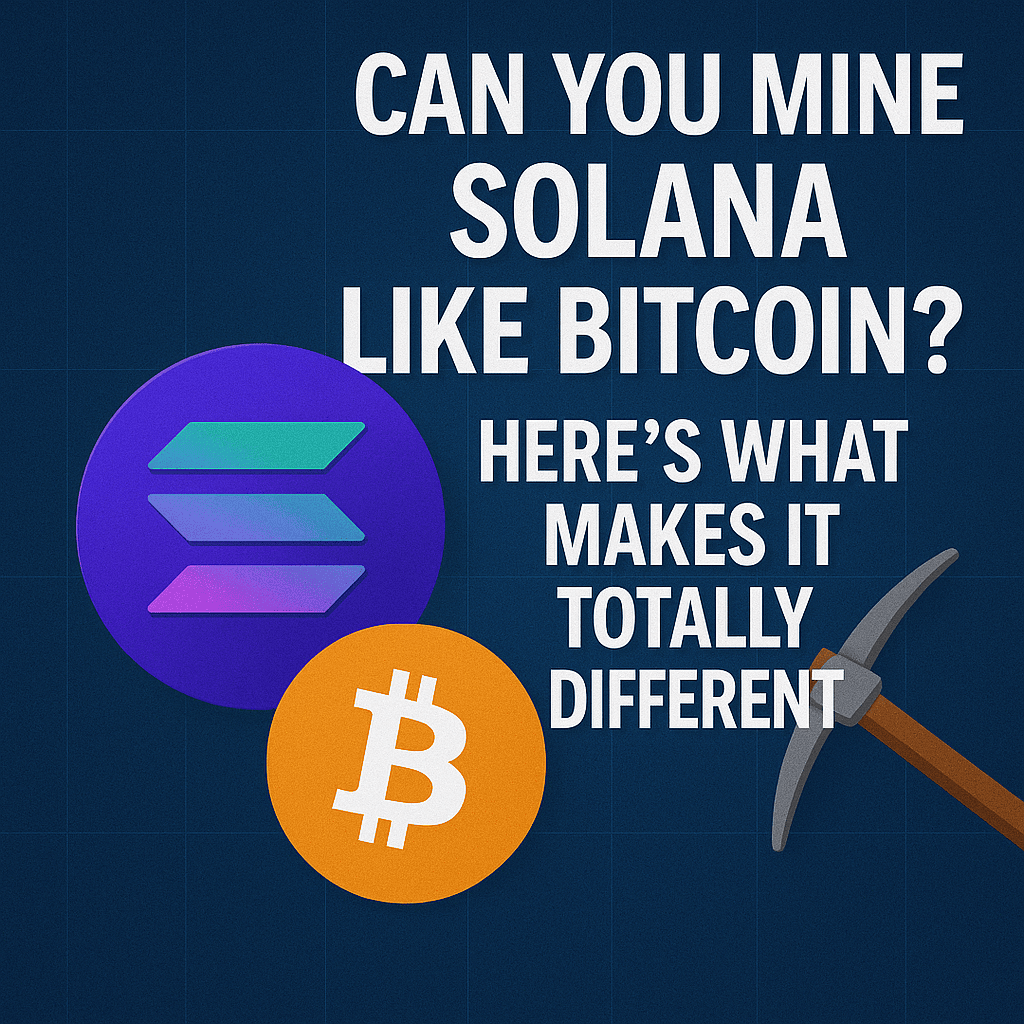Last Updated on April 25, 2025
The cryptocurrency space continues to attract newcomers in 2025, and with this influx of interest comes many questions about how different blockchain networks operate. One common question among crypto enthusiasts and potential investors is whether Solana (SOL) can be mined in the same way as Bitcoin (BTC). The short answer is no—but understanding the fundamental differences between these two approaches reveals fascinating insights into blockchain technology’s evolution and diversity.
The Fundamental Difference: Consensus Mechanisms
At the core of every blockchain is a consensus mechanism—the protocol that determines how the network agrees on which transactions are valid and should be added to the blockchain. This is where Solana and Bitcoin diverge completely.
Bitcoin’s Proof of Work (PoW)
Bitcoin operates on what’s called a Proof of Work (PoW) consensus mechanism:
- Mining Process: Computers (miners) compete to solve complex mathematical puzzles
- Resource Intensive: Requires significant computational power and electricity
- Reward System: Successful miners receive newly minted Bitcoin plus transaction fees
- Equipment Needed: Specialized ASIC (Application-Specific Integrated Circuit) hardware
- Decentralization Method: Anyone with proper hardware can participate, though economies of scale have led to mining consolidation
This is what people traditionally think of as “cryptocurrency mining”—running specialized equipment that consumes electricity to solve computational puzzles and earn rewards.
Solana’s Proof of History (PoH) and Proof of Stake (PoS)
Solana takes a radically different approach with its hybrid consensus mechanism:
- Proof of History (PoH): A method to cryptographically verify the passage of time between events
- Proof of Stake (PoS): Validators are selected based on the amount of SOL they “stake” or lock up as collateral
- No Mining: There is no computational puzzle-solving or traditional mining
- Validator Selection: Network participants become validators by staking SOL tokens
- Energy Efficiency: Consumes significantly less energy than PoW systems
Why Can’t You Mine Solana?
Understanding why Solana cannot be mined requires examining several key aspects of its architecture:
1. Token Distribution Model
Unlike Bitcoin, which distributes new coins through mining:
- Pre-minted Supply: Solana had a fixed supply of tokens created at genesis
- No Block Rewards: New SOL is not created through block validation
- Inflation Model: Solana does have inflation, but rewards go to validators and delegators through staking, not mining
2. Technical Architecture
Solana was designed with specific technical goals that made PoW mining unsuitable:
- High Throughput: Designed to process thousands of transactions per second
- Low Latency: Aims for confirmation times of under a second
- Scalability Focus: Architecture prioritizes network scaling over the distributed mining model
3. Energy and Environmental Considerations
Solana’s design choices reflect concerns about:
- Energy Consumption: PoW mining’s significant electricity usage
- Carbon Footprint: Environmental impact of large-scale mining operations
- Resource Efficiency: Maximizing transaction throughput per unit of energy consumed
How to Participate in the Solana Network
While you cannot mine Solana in the traditional sense, there are several ways to participate in the network and earn rewards:
Becoming a Validator
Validators are the Solana equivalent of miners, but with key differences:
- Requirements: Powerful server with high CPU cores, RAM, and storage
- Initial Investment: Significant SOL stake plus hardware costs (typically 6-figures USD in 2025)
- Technical Knowledge: Requires server management and maintenance expertise
- Responsibilities: Processing transactions and maintaining network security
- Rewards: Earning transaction fees and staking rewards
Running a Solana validator is complex and capital-intensive, making it inaccessible to most individual participants.
Delegating Stakes (Staking)
The more accessible option for most Solana participants:
- Process: Delegate your SOL to existing validators
- Minimum Requirements: As little as 1 SOL can be staked
- Technical Barrier: Minimal, can be done through user-friendly wallets
- Risk Level: Lower than running a validator, though slashing risks exist
- Reward Rate: Typically 5-7% annual yield (as of 2025), minus validator commission
Liquid Staking Protocols
An even more flexible approach to earning on Solana:
- Mechanism: Receive liquid tokens representing staked SOL
- Benefits: Maintain liquidity while earning staking rewards
- Popular Options: Marinade Finance, Lido, and others
- Use Cases: Can be used in DeFi while still earning base staking returns
Comparative Analysis: Solana vs. Bitcoin Participation
To better understand the differences, consider these comparisons:
AspectBitcoin MiningSolana Validation/StakingEntry Cost$5,000-$15,000 for basic setup$500,000+ for validator, $10+ for stakingTechnical Knowledge RequiredModerateHigh for validators, Low for stakersEnergy ConsumptionVery HighVery LowHardware DepreciationSignificantModerate for validators, None for stakersReward ConsistencyVariable based on hash rateMore consistent but affected by network parametersLocation ConstraintsElectricity costs, cooling needsInternet reliability, legal jurisdiction
The Future of Blockchain Consensus
The distinction between Solana and Bitcoin represents a broader evolution in blockchain technology:
Industry Trends
- Specialization: Blockchains optimizing for specific use cases rather than general solutions
- Hybrid Approaches: Combining elements of different consensus mechanisms
- Institutional Participation: Growing involvement from larger entities in network validation
Environmental Considerations
As environmental concerns around blockchain energy usage grow, Solana’s approach represents a direction many protocols are moving toward:
- Carbon Footprint: Solana’s entire network uses roughly the same energy as a few hundred American households
- Sustainability: No need for continually upgrading energy-intensive hardware
- Regulatory Alignment: Better positioned for potential future environmental regulations
Common Misconceptions About Solana “Mining”
Several misconceptions persist about participating in the Solana network:
“Cloud Mining” for Solana
Beware of services advertising “Solana mining” or “Solana cloud mining”:
- These are typically scams, as Solana cannot be mined
- Legitimate Solana staking services exist but do not involve mining
- Always research thoroughly before investing in any service claiming to mine Solana
Confusing Staking with Mining
While both can generate passive income, they work fundamentally differently:
- Mining involves actively solving computational problems
- Staking involves passively securing the network by locking up tokens
- Mining requires specialized hardware; staking requires only tokens
Proof of Work vs. Proof of Stake Returns
Returns on investment differ significantly:
- PoW mining returns depend on electricity costs, hardware efficiency, and competition
- PoS staking returns are more predictable but generally lower percentage yields
- Mining equipment depreciates rapidly; staked tokens maintain their base value
Who Benefits Most from Solana’s Approach?
Solana’s consensus design creates different winners and losers compared to Bitcoin’s mining approach:
Beneficiaries of Solana’s Design
- Developers: Building applications that require high throughput and low fees
- Users: Experiencing faster transactions and lower costs
- Environmentally-conscious investors: Participating without significant carbon footprint
- Capital-rich participants: Larger stake equals more influence and rewards
Challenges for Traditional Miners
For those accustomed to Bitcoin mining, Solana presents:
- Different skill requirements: Server operation versus mining rig management
- Capital structure changes: Token acquisition versus hardware investment
- Passive versus active participation: Less ongoing management needed
- Centralization concerns: Higher barriers to entry for validators
How to Start Participating in Solana Today
If you’re interested in earning rewards on the Solana network:
For Beginners: Simple Staking
- Create a wallet: Phantom, Solflare, or other Solana-compatible wallets
- Acquire SOL: Purchase from exchanges and transfer to your wallet
- Choose a validator: Research performance, commission rates, and reliability
- Delegate your stake: Follow wallet instructions to delegate to your chosen validator
- Monitor your rewards: Rewards accumulate automatically in your staking account
For Advanced Users: Liquid Staking Options
- Compare protocols: Research liquid staking derivatives like mSOL or stSOL
- Evaluate risks: Understand smart contract and protocol risks
- Stake through protocols: Follow specific instructions for your chosen platform
- Utilize liquid tokens: Explore DeFi options for your liquid-staked SOL
- Optimize yield strategies: Stack additional DeFi yields on top of base staking
Conclusion: Different Paths to Blockchain Participation
While you cannot mine Solana like Bitcoin, this represents an intentional design choice rather than a limitation. Solana’s approach prioritizes scalability, energy efficiency, and transaction throughput over the distributed mining model that made Bitcoin revolutionary.
For participants, the key decision is which blockchain participation model aligns with your resources, technical capabilities, and investment thesis. Both systems offer opportunities to support network operations and earn rewards, but through fundamentally different mechanisms.
Understanding these differences is crucial not just for making informed investment decisions, but also for appreciating the diverse approaches to solving the blockchain trilemma of security, decentralization, and scalability. As the blockchain ecosystem continues to evolve, these different consensus mechanisms will likely continue to coexist, each serving different needs in the expanding digital asset landscape.
Disclaimer: This article is for informational purposes only and does not constitute financial or investment advice. Cryptocurrency participation involves risk, and you should conduct your own research before making any financial decisions.

